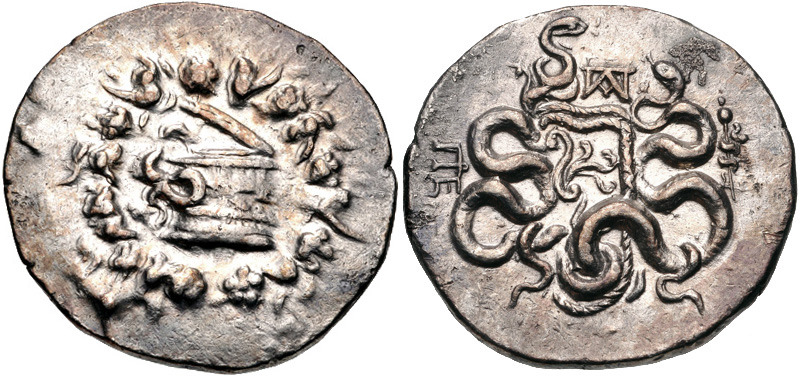Pergamum, silver, cistophori (123-88 BCE) Carbone
From SILVER
123 BCE - 88 BCE Silver 47,389 kg
Description
| ObverseInscription or printing placed on the obverse.: | Cista mystica with serpent, all within ivy wreath |
| ReverseInscription or printing placed on the reverse.: | Bowcase with serpents, monogram above, civic monogram to left, serpent-staff to right |
Mint and issuing power
| MintIdentifies the place of manufacture or issue of a numismatic object.: | Pergamum | Ancient regionAncient region.: | Mysia | Modern countryModern country: Turkey | AuthorityIdentifies the issuing power. The authority can be "pretended" when the name or the portrait of X is on the coin but he/she was not the issuing power. It can also be "uncertain" when there is no mention of X on the coin but he/she was the issuing power according to the historical sources: | Roman Republic |
Chronology
| FromIdentifies the initial date in a range assigned in a numismatic context. | 123 BCE | toIdentifies the final date in a range assigned in a numismatic context.. | 88 BCE | PeriodTime period of the numismatic object.: Hellenistic 323-30 BC |
Physical description
| MetalThe physical material (usually metal) from which an object is made.: | Silver |
Median weightMedian of the weights of numismatic objects (in grams). in grams | 12.70 | DenominationTerm indicating the value of a numismatic object. Examples: tetradrachm, chalkous, denarius.: | cistophorus |
StandardStandard.: | Cistophoric |
Image

S1725 Pergamum cistophori 123-.jpg [1]
References
| Die study referencePublication of the study: | Carbone 20201Carbone 2020, p. 55-76 | ||
| Coin series referenceReference to coin series study: | Sear II2Sear II, n° 3947-3950 | ||
Obverse dies distribution
| FrequencyFrequency of specimen in distribution. ᵖ | Number of obversesNumber of obverse dies. ᵖ (o) | % (o) | Number of coinsNumber of coins. (n) | % (n) | Die nameName(s) of the die(s). |
| 1 | 44 | 27.5 | 44 | 6.9 | 56, 57, 58, 59, 66, 67, 69, 82, 86, 88, 89, 97, 101, 103, 105, 112, 120, 125, 126, 129, 130, 140, 146, 151, 152, 153, 158, 160, 163, 172, 178, 185, 189, 190, 192, 194, 196, 199, 202, 205, 207, 208, 209, 210 |
| 2 | 21 | 13.13 | 42 | 6.58 | 51, 53, 55, 61, 72, 78, 92, 95, 106, 108, 109, 110, 114, 123, 149, 155, 161, 162, 183, 188, 198 |
| 3 | 24 | 15 | 72 | 11.29 | 52, 60, 63, 65, 68, 74, 75, 76, 80, 84, 113, 115, 116, 131, 132, 139, 141, 157, 168, 179, 182, 187, 191, 200 |
| 4 | 15 | 9.38 | 60 | 9.4 | 53, 81, 87, 93, 111, 135, 136, 150, 156, 166, 169, 173, 181, 186, 203 |
| 5 | 18 | 11.25 | 90 | 14.11 | 64, 70, 73, 77, 91, 99, 100, 107, 117, 118, 133, 138, 143, 144, 164, 171, 180, 184 |
| 6 | 10 | 6.25 | 60 | 9.4 | 62, 121, 127, 134, 142, 148, 159, 175, 176, 206 |
| 7 | 6 | 3.75 | 42 | 6.58 | 85, 104, 119, 128, 145, 165 |
| 8 | 9 | 5.63 | 72 | 11.29 | 71, 83, 90, 96, 98, 102, 122, 137, 170 |
| 9 | 5 | 3.13 | 45 | 7.05 | 79, 94, 124, 147, 154 |
| 10 | 1 | 0.63 | 10 | 1.57 | 177 |
| 11 | 5 | 3.13 | 55 | 8.62 | 174, 195, 197, 201, 204 |
| 12 | 1 | 0.63 | 12 | 1.88 | 167 |
| 34 | 1 | 0.63 | 34 | 5.33 | 193 |
| Total | 160 of 160 | 100.04 | 638 of 638 | 100 |
Reverse dies distribution
no distribution is available
Quantification
| Number of obversesNumber of obverse dies. ᵖ (o) | 160 | Number of singletons (o1)The number of singleton coins. ᵖ | 44 |
| Number of reverse diesNumber of reverse dies. (r) | 496 | Number of coinsNumber of coins. (n) | 638 |
| Coins per obverse dieNumber of coins per obverse die. (n/o) | 3.99 | Coins per reverse dieNumber of coins per reverse die. (n/r) | 1.29 |
| Reverse per obverse ratioRatio of obverse dies divided by reverse dies. (r/o) | 3.1 | Percentage of singletons (o1)number of coins (n) divided by the number of singletons (o1) ᵖ | 27.5 % |
| Original number of dies (O) (Carter 1983 formula)The estimation of the number of coins according to Carter 1983 ᵖ | 186.57 | Coins struck if 20,000 as average productivity per dieCoins made if the average productivity for obverses (according to Carter) is 20,000. ᵖ | 3,731,400 |
| Original number of dies (O) (Esty 2011 formula)The estimation of the number of coins according to the singleton formula in Esty 2011 ᵖ (O) | 213.56 | Survival rate if 20,000 as average productivity per dieSurvival rate if average productivity is 20,000. ᵖ | 0.00017 |
| Coverage (o = % of O) (Esty 1984 formula)Esty 1984 - coverage (% of O) ᵖ (o = % of O) | 93.1% | Die productivity if survival rate 1/2,000Average productivity if survival rate is 1/2,000. ᵖ | 6,839.26 |
| Weight of silver (in kg) if 20,000 coins per die (O = Carter formula)Carter 1983 * Median weight * 20000 (*10 if gold or electrum) ᵖ | 47,389 kg <br /> 47,389 kg | Die productivity if survival rate 1/5,000Average productivity if survival rate is 1/5,000. ᵖ | 17,098.14 |
Remarks